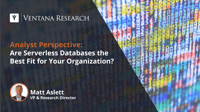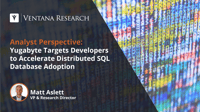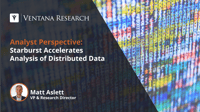Ventana Research recently announced its 2024 Market Agenda for Digital Technology. This agenda is designed to provide expertise to enterprises across various industries, helping them prioritize technology investments that enhance workforce effectiveness, customer engagement and enterprise agility. Digital Technology is especially important for CIO and Chief Digital Officers looking to rationalize and modernize their IT portfolio. Our expertise will see a significant expansion on this topic in...
Read More
Topics:
Business Continuity,
Cloud Computing,
IT Service Management,
Digital Technology,
Digital Security,
Observability,
DevOps and Platforms,
IoT and Edge Computing,
Intelligent Automation,
ITOps
Data is one of the most valuable assets an organization owns, and a robust data backup and recovery system is foundational to protecting it. Weak data protection efforts jeopardize resilience and business continuity. With data residing in multiple places – including on-premises servers and public and private cloud environments – it is difficult to ensure that all data is backed up and recoverable in the event of a disaster.
Read More
Topics:
Business Continuity,
Cloud Computing,
Digital Business,
Digital Security,
Resilience,
Backup,
Recovery,
Multi-Cloud
For years various types of systems have produced log files to help with monitoring, debugging and performance management. Often, this information was used in forensic analyses of why interruptions in service or other problems occurred. In many cases, log files are still used this way. But systems have grown more complicated, and many more devices are instrumented. Systems have been decomposed into much finer-grained, interdependent services. Infrastructure is now distributed between on-premises...
Read More
Topics:
Business Continuity,
Digital Technology
With Ventana Research’s 2023 Market Agenda, we continue the guidance we’ve offered for two decades to help organizations derive maximum value from digital business technology investments. Through our market research and expertise, we identify trends and best practices and share insights on how to achieve technological effectiveness, particularly in key processes and systems to engage the workforce.
Read More
Topics:
Performance Management,
Business Continuity,
Digital transformation,
Digital Business,
Digital Security,
Digital Communications,
Work Management,
Experience Management,
Governance & Risk,
Sustainability & ESG
In my previous perspectives on cloud computing, I addressed some of the realities of cloud costs as well as hybrid and multi-cloud architectures. In the midst of the pandemic, my colleague, Mark Smith, authored a series of perspectives on considerations for business continuity in general, beginning with this look at some of the investments organizations must make to mitigate the risk of business disruptions. In this perspective, I’d like to address some of the realities of business continuity...
Read More
Topics:
Business Continuity,
Cloud Computing,
Digital Technology,
Digital Business
The server is a key component of enterprise computing, providing the functional compute resources required to support software applications. Historically, the server was so fundamentally important that it – along with the processor, or processor core – was also a definitional unit by which software was measured, priced and sold. That changed with the advent of cloud-based service delivery and consumption models.
Read More
Topics:
Business Continuity,
Cloud Computing,
Data,
Digital Technology,
Digital Business,
data platforms,
Analytics & Data
Over a decade ago, I coined the term NewSQL to describe the new breed of horizontally scalable, relational database products. The term was adopted by a variety of vendors that sought to combine the transactional consistency of the relational database model with elastic, cloud-native scalability. Many of the early NewSQL vendors struggled to gain traction, however, and were either acquired or ceased operations before they could make an impact in the crowded operational data platforms market....
Read More
Topics:
Business Continuity,
Cloud Computing,
Data,
Digital Technology,
Digital Business,
data platforms,
Analytics & Data
I recently described the growing level of interest in data mesh which provides an organizational and cultural approach to data ownership, access and governance that facilitates distributed data processing. As I stated in my Analyst Perspective, data mesh is not a product that can be acquired or even a technical architecture that can be built. Adopting the data mesh approach is dependent on people and process change to overcome traditional reliance on centralized ownership of data and...
Read More
Topics:
Business Continuity,
Analytics,
Business Intelligence,
Data Governance,
Data Integration,
Data,
Digital Technology,
data lakes,
Digital Business,
data platforms,
Analytics & Data
With the announcement of Ventana Research’s 2022 Market Agenda, our expertise in Digital Business continues to advance the market need for effective investments into technology, and I will outline here the key areas of focus to provide insights to organizations that can increase their organizational resilience and workforce readiness. We are proud to provide expertise on ensuring technological effectiveness through our market research and experience in providing guidance on trends and best...
Read More
Topics:
Performance Management,
Business Continuity,
Governance, Risk & Compliance (GRC),
Digital transformation,
Digital Business,
Digital Security,
Digital Communications,
Sustainability Management,
Work Management,
Experience Management
The term NoSQL has been a misnomer ever since it appeared in 2009 to describe a group of emerging databases. It was true that a lack of support for Structured Query Language (SQL) was common to the various databases referred to as NoSQL. However, it was always one of a number of common characteristics, including flexible schema, distributed data processing, open source licensing, and the use of non-relational data models (key value, document, graph) rather than relational tables. As the various...
Read More
Topics:
Business Continuity,
Analytics,
Data,
Digital Technology,
Digital Business,
data platforms



















